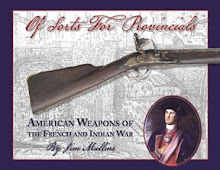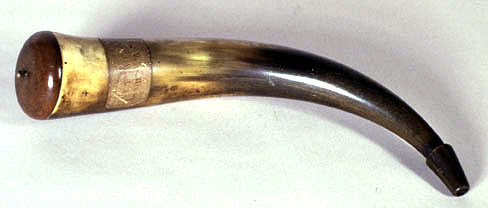http://www.trackofthewolf.com/categories/partDetail.aspx?catId=1&subId=12&styleId=39&partNum=BOOK-R18CPH&AspxAutoDetectCookieSupport=1&as=1
Overall it covered the process very well, and I recommend checking it out- even if you have done this before, it had some great hints and templates worth exploring.
I had previously purchased a very simple, plain horn (similar to the McAfee horn below but with a flat base plug) from horner Jim Leach, I highly recommend starting with something on the plain side. J.D.F. Smyth and at least one Va Gazette runaway ad mention carved horns but surviving examples are few and far between. Unlike some other regions (ie F&I era Lake George, 1740s or 1770s New England schools), there aren't a ton of published horns with an 18th century Virginia provenance (carved or plain) that I have been able to find (exclusive of the Fort Pitt/Forbes road horns).
For a great discussion of Virginia and Pennsylvania horns I highly recommend viewing Mike Burke's excellent 2018 School of the Longhunter lecture at Prickett's fort
As an aside, a nifty base plug from a horn was excavated from Fort Ligonier in PA and is shown in ARCHAEOLOGICAL INVESTIGATION OF FORT LIGONIER 1960-1965 by Grimm. It was 2.6 inches in diameter, about 1/2 inch thick at the thickest (flat interior surface, convex top) and had originally been fastened with pegs that were replaced with nails during it's working life. Two nails secured the now missing strap to the plug.
Portrait of John Seabrook (1768–1844) by The Payne Limner, 1780, Richmond, Virginia. Oil on canvas; HOA (canvas): 38-1/8”, WOA (canvas): 32-1/2”. Collection of Patricia S. and William T. Wilson, III; on loan to the Museum of Early Southern Decorative Arts (MESDA), Acc. 5975.3
For other online images of horns with a Virginia provenance, American Revolution Center has images of the Waller horn in their time line.
and on the plainer side, the "McAfee" horn is online here at Cowan auctions (far left, large domed plug):
Guilford Court House has another example:
Powder horn
Used by a Virginia militiaman in the battle of Guilford Courthouse.
Horn, metal. D 7.8, L 36 cm (roughly 14 inches long x 3 inches in diameter)
Guilford Courthouse National Military Park, GUCO 1999
William Fleming's 1782 Powder horn at MESDA
Used by a Virginia militiaman in the battle of Guilford Courthouse.
Horn, metal. D 7.8, L 36 cm (roughly 14 inches long x 3 inches in diameter)
Guilford Courthouse National Military Park, GUCO 1999
William Fleming's 1782 Powder horn at MESDA
Since I had the plain end of things well covered, I elected to try a large lobed horn with a horn I picked up from Track of the Wolf.
First, the interior hollow was measured and the tip was cut off, then the horn was scraped and filed overall a bit.
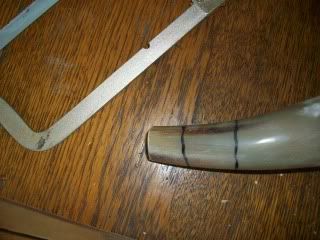
Then the opposite end was cut off, and I drew in the lines for my "lobes".
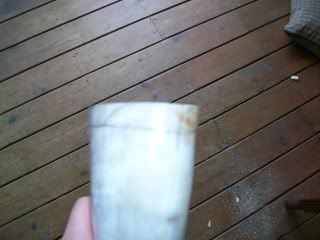
Then using a saw and file shaped them
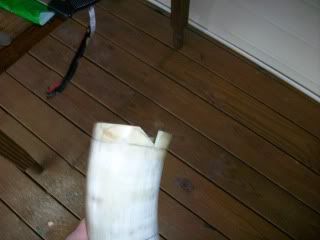
until I got the basic design I wanted and drilled the strap holes into the lobes.
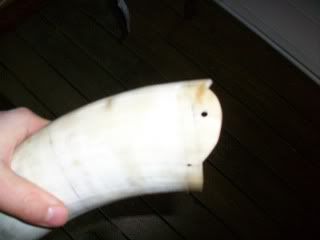
I began forming the base or butt plug out of some pine.
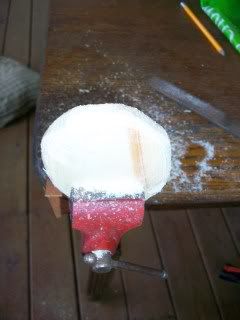
I worked at this until I got a pretty good friction fit-this image shows that portion of work in process.

Once the pine plug was snug, I drilled six holes and attached the plug with wooden pegs.
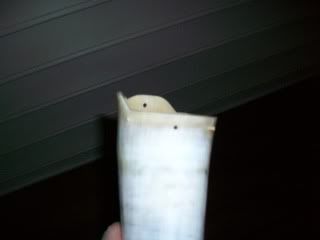
The pegs were then cut flush and I applied a bit of linseed oil to the exterior of the plug to help seal it from moisture. I then turned my attention to shaping the other end of the horn with a file and knife. I started by marking flats and lines and worked them down with a file.
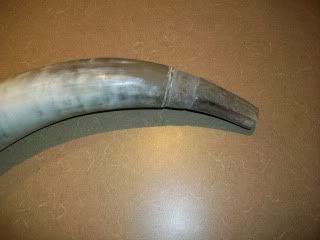
Polished that up a bit (more filing) and carved a soft wood plug.

The horn is now ready for dying, engraving or adding a strap if that isn't desired (a thin leather strap, hemp webbing or a cord works for many applications). I elected to keep this horn looking fairly "new" I don't personally understand why folks want to carry horns that look 250 years old to reenactments, but hey suit yourself! Overall, my horn is a bit on the clunky and crude (home made looking) side, but is functional and came together for under $20 in materials.
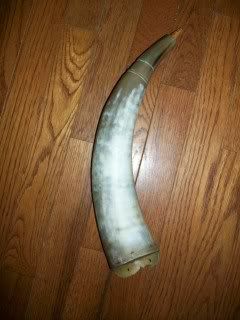
After a bit more tinkering:
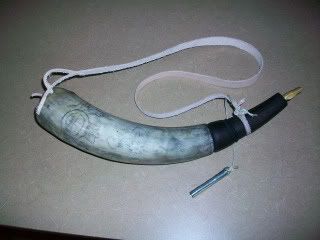
some nifty 18th century info on dying horn can be found here:
http://books.google.com/books?id=k5jcid_fsa4C&pg=RA1-PT652&dq=to+dye+horn+yellow&hl=en&ei=z9ScTaP9CaPn0QHS67XlDA&sa=X&oi=book_result&ct=result&resnum=3&ved=0CEsQ6AEwAg#v=onepage&q=to%20dye%20horn%20yellow&f=false
